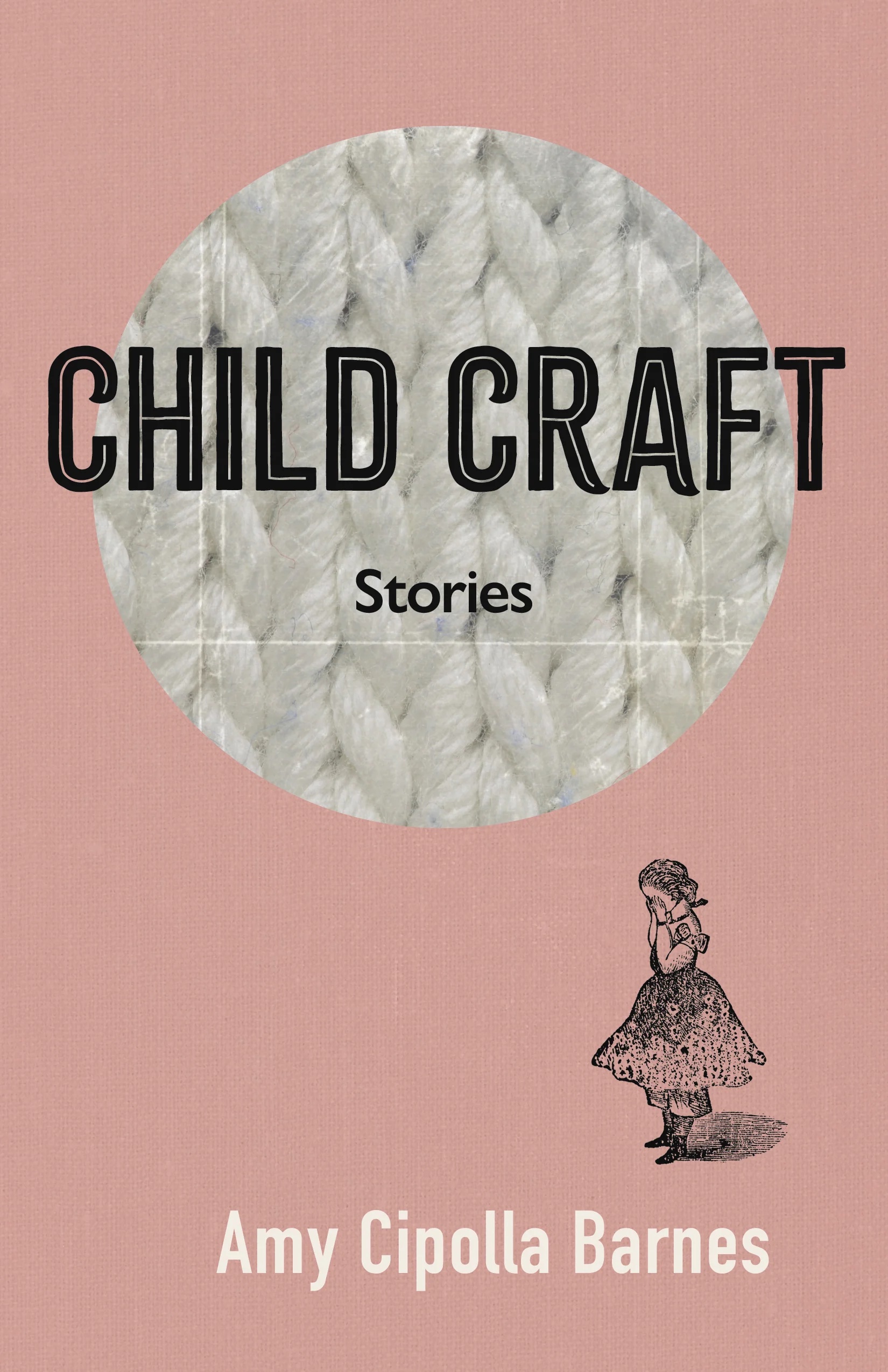Writing from the Senses: Talking with Amy Cipolla Barnes about her Book: Child Craft
Leave a commentJune 30, 2023 by The Citron Review
by Charlotte Hamrick

Amy Cipolla Barnes is known for her unique and skillful Flash Fiction, utilizing the qualities of surrealism and slipstream to immerse her readers in her writing. As a fan of Amy’s work, one thing I like is how it makes you think and see the situations she writes about in a new and exciting way.
Child Craft is Amy’s latest (upcoming) collection of Flash Fiction and it is a beautiful set of stories that kept me reading and wanting more. I had a conversation with Amy recently about this collection.
Talk about the relationship between personal experience and imagination in the writing of these stories.
The collection is a mix of fiction and CNF (heavy on the C) but without any specification of which is which. While these are “stories” by label, many of the pieces walk the line between my own life and fiction. As an example, “The Art of Brutalism” published by The Citron Review encompasses a childhood trip and my emotions surrounding the Oklahoma City bombing. It was a very disorienting time on its face but to be in the vicinity of the bombing just days after it happened made an impact too.
Writing a truly traditional memoir has never been my process, so I imagined the details of that day with mentions of The Wizard of Oz – we were coming from Kansas – and visual cues of the color gray tied into the Greyhound bus. It’s been decades since that day and the details I remember are still punctuated by the smells, visuals and other sensory cues. The title of the piece and simple date at the beginning are doing a lot of work at framing the where and when without a ton of exposition. The touchpoints of memorable things. The architecture of buildings, and life.
As I write any of my stories, I think I take that same approach to ground my stories even as they veer into surrealism or focus on tough topics. In “The Art of Brutalism,” the subject matter is overall dire but by injecting sensory mentions, pop culture and familiar dates.
I remember it well. I think you did a spectacular job writing about a traumatic event and how traveling through the aftermath affected you and your sister. Inserting surreal elements deflected the horror just a bit without obscuring it. It’s so skillfully written.
Which of the characters do you relate to the most and why?
Because these stories do have ties to childhood, I relate to most of them. If the stories aren’t being told in first-person-me, they are often a sideways reflection of how childhood me might be reacting or standing in as a secondary character to narrate. I was not a kidnapped child or a child of an alcoholic parent, but I grew up near the BTK killer and my nieces were daughters of alcoholic parents. In my Bureau Dispatch CNF, I speak directly to some of those childhood experiences in 1st POV with myself as the unreliable child narrator. I always strive to use surreality or an unreliable child voice carefully to tell stories – there still needs to be an authenticity.
“Ansel Adams Had Acne” was a delightful read. I loved the pop culture references and the fun of imagining this iconic photographer as a teen working the photo counter at Walmart. Do you remember what sparked this story?
A little nostalgia and oddly, current photography. My teenager needed printed out pictures for several projects and it was a process. As I fiddled with the app and thought about photo processing when I was a teenager, my mind (naturally or not) jumped to how would a famous photographer get their images processed. I know the how because my oldest kid spent time with a 35mm camera and in the school dark room but I couldn’t help but wonder — what would happen if that wasn’t available.
Which story did you have the hardest time writing?
“Amending Second Grade” was the hardest story for several reasons. I have two kids that are in school and we know families affected by school shootings including one just miles from our house this spring. Secondarily, this particular flash has been workshopped, edited and submitted – all without being accepted for publication. I chose to put it in the collection as a “new” piece, in part because it felt maybe like the most relevant “child craft” response.
Gun violence is a tough subject. When I read “Amending Second Grade” I really felt pelted by the gun and shooting prose which, I imagine, is the point. My takeaway is that the story shines a spotlight on the malaise some people seem to have surrounding mass shootings and gun violence in general. Do you think the reason it wasn’t picked up by a litmag is because it’s so immersive in gun culture – that maybe they just don’t get the point?
I’m honestly not sure why this story didn’t land but I wrote it in a moment when I felt immersed in what is happening, when it felt like it was all around in kind of a fugue state. It may be it just needs to find the right journal. It fit the theme of “child craft” and I made the decision to include it here instead. In my mind at least, it may be a better fit than some of the other stories because it cuts up the idea of gun violence and “glues” it all over the characters and their lives completely — a collage of childhood.
If you were to write a spin-off about a side character, which would you pick?
I think instead of writing a spin-off about a specific character, I would like to write the future version of characters, beyond the tiny window of the presented flash. As I write, I often change the POV from 1st to 2nd or 3rd, and also sometimes tense. Further, if I get stuck I will also have a secondary character tell their view of the story; in The Art of Brutalism, I would try having the bus driver tell the story or one of the protagonist’s seat mates. Even if that POV isn’t ultimately the one I end up with, it can help illuminate the viewpoint I do utilize.
Who are your biggest influences?
My influences vary and include writers like Kate Chopin, Gene Stratton Porter, Flannery O’Connor, Eudora Welty, Richard Wright, Harper Lee, Louisa May Alcott. I grew up in the Midwest and read Midwestern authors like Porter, but was always drawn to Southern authors. Once I settled in the South as a young adult, I found myself meshing both regional voices.
But I also find the most inspiration and influence in contemporary writers and my peers that are writing flash, essays, longer prose and books that amaze me daily. There are far too many to list here but my bookshelves speak to the range of books published in the last decade alone.
I also find inspiration and influence in being an editor for publications – reading submissions daily is exciting because I get to see the newest words, the freshest ideas from first time writers, emerging authors and established ones too. Finding gems in the submission queue influences me in ways that reading already-published works can’t, often-painfully aware of the talent infused in the words that are being submitted. I am influenced and inspired by the range of writing that I get to read sometimes for the first time – I’ve been able to help guide teenage writers to publication and awards and also octogenarians.
What is the most valuable piece of advice you’ve been given about writing?
This is maybe harder to answer than the other questions, in part because there’s always indirect and direct advice in the literary space. I’ve contemplated and given different answers to this question. Some more positive advice than others. I think that my response to advice may be more crucial than the actual advice sometimes.
In my college creative writing courses, the very well-published professor read his own work to us frequently. It was impactful and memorable. I can still remember some of the lines decades later. His advice at the time sent me into a bit of a tailspin. I was maybe twenty-years-old. His very critical analysis of the writing in the course was followed up with what felt like harsh statements:
You have no life experience. You are naive. You live in the Midwest. You haven’t traveled. Or been married. Fought in a war. Or had kids. Or owned your own home. Or pay your own mortgage. You have no real perspective.
We all shifted uncomfortably. Some of the people in the class had done some of those things but at heart, most of us were naive and inexperienced. He told us we were good writers but asked if we wanted to be better writers. How could we write about things that we had little awareness of? I did some crying and spent time not writing.
Shift forward three decades. His “advice” feels relevant. I have done most of those things. Is my writing better than what I was writing as a young adult? I’m not sure. Maybe it’s a bit of a “Wonder Years” flashback effect. I was a child. I had a mother. I hopefully am able to write about both of those things in a more illuminating way now because I’m now also a mother, although I don’t think that’s a requirement. So valuable advice to get some life experience? Maybe.
Finally, what perspectives or beliefs have you challenged with this work?
I think that the collection does its best to explore parenthood and childhood, blurred a little by surrealism. By integrating things that aren’t real like a pickle jar as a hiding place, I’ve tried to take a different approach to tough topics.
I agree with that, Amy. It’s a wonderful and exciting read. Congratulations and thank you for talking with me about Child Craft.
Amy Cipolla Barnes is the author of three short fiction collections: Ambrotypes published by word west, Mother Figures at ELJ Editions and Child Craft, forthcoming from Belle Point Press in September, 2023. Her words have appeared in a wide range of publications including: The Citron Review, JMWW Journal, Janus Lit, Flash Frog, Nurture Lit, Complete Sentence, Gone Lawn, The Bureau Dispatch, Nurture Lit, X-R-A-Y Lit, McSweeney’s, SmokeLong Quarterly, Southern Living, Motherly, Allrecipes and many others. She’s been nominated for Best of the Net, the Pushcart Prize, Best Microfiction, long-listed for Wigleaf Top 50 in 2021, 2022 and 2023, and included in Best Small Fictions 2022. She’s a Fractured Lit Associate Editor, Gone Lawn co-editor, Ruby Lit assistant editor and reads for The MacGuffin, Best Small Fictions, and Narratively. Child Craft is expected to be published September 5, 2023 by Belle Point Press and can be pre-ordered until then.
Charlotte Hamrick began writing creatively in her 50s. Recent work has been published in Best Small Fictions 2022 and 2023, Atticus Review, Still: The Journal, Louisiana Literature, and her work was longlisted in the Wigleaf Top 50 2023. She writes intermittently on her free Substack, The Hidden Hour and her website is charhamrick.com.
Category: Interviews, Fiction, Zest, 2023 | Tags: The Citron Review, Charlotte Hamrick, Q&A, Zest, Amy Cipolla Barnes, Summer 2023, Child Craft

